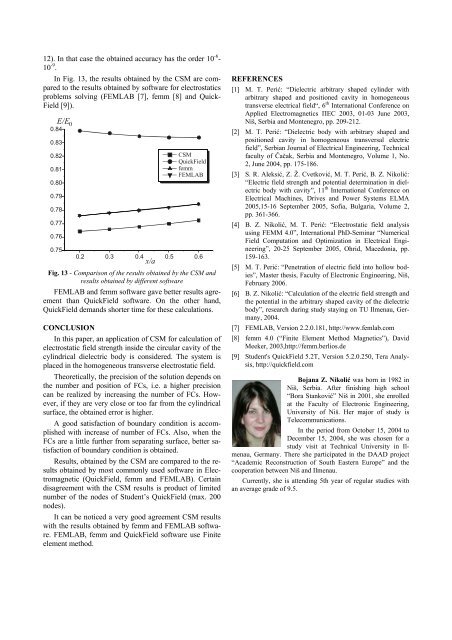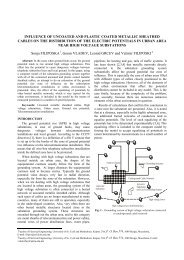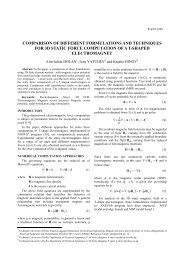denoted
electrostatic field analysis in dielectric body with cavity
electrostatic field analysis in dielectric body with cavity
You also want an ePaper? Increase the reach of your titles
YUMPU automatically turns print PDFs into web optimized ePapers that Google loves.
12). In that case the obtained accuracy has the order 10 -6 -<br />
10 -9 .<br />
In Fig. 13, the results obtained by the CSM are compared<br />
to the results obtained by software for electrostatics<br />
problems solving (FEMLAB [7], femm [8] and Quick-<br />
Field [9]).<br />
E/E 0<br />
0.84<br />
0.83<br />
0.82<br />
0.81<br />
0.80<br />
0.79<br />
0.78<br />
0.77<br />
0.76<br />
0.75<br />
0.2 0.3 0.4 0.5 0.6<br />
x/a<br />
CSM<br />
QuickField<br />
femm<br />
FEMLAB<br />
Fig. 13 - Comparison of the results obtained by the CSM and<br />
results obtained by different software<br />
FEMLAB and femm software gave better results agreement<br />
than QuickField software. On the other hand,<br />
QuickField demands shorter time for these calculations.<br />
CONCLUSION<br />
In this paper, an application of CSM for calculation of<br />
electrostatic field strength inside the circular cavity of the<br />
cylindrical dielectric body is considered. The system is<br />
placed in the homogeneous transverse electrostatic field.<br />
Theoretically, the precision of the solution depends on<br />
the number and position of FCs, i.e. a higher precision<br />
can be realized by increasing the number of FCs. However,<br />
if they are very close or too far from the cylindrical<br />
surface, the obtained error is higher.<br />
A good satisfaction of boundary condition is accomplished<br />
with increase of number of FCs. Also, when the<br />
FCs are a little further from separating surface, better satisfaction<br />
of boundary condition is obtained.<br />
Results, obtained by the CSM are compared to the results<br />
obtained by most commonly used software in Electromagnetic<br />
(QuickField, femm and FEMLAB). Certain<br />
disagreement with the CSM results is product of limited<br />
number of the nodes of Student’s QuickField (max. 200<br />
nodes).<br />
It can be noticed a very good agreement CSM results<br />
with the results obtained by femm and FEMLAB software.<br />
FEMLAB, femm and QuickField software use Finite<br />
element method.<br />
REFERENCES<br />
[1] M. T. Perić: “Dielectric arbitrary shaped cylinder with<br />
arbitrary shaped and positioned cavity in homogeneous<br />
transverse electrical field“, 6 th International Conference on<br />
Applied Electromagnetics ПEC 2003, 01-03 June 2003,<br />
Niš, Serbia and Montenegro, pp. 209-212.<br />
[2] M. T. Perić: “Dielectric body with arbitrary shaped and<br />
positioned cavity in homogeneous transversal electric<br />
field”, Serbian Journal of Electrical Engineering, Technical<br />
faculty of Čačak, Serbia and Montenegro, Volume 1, No.<br />
2, June 2004, pp. 175-186.<br />
[3] S. R. Aleksić, Z. Ž. Cvetković, M. T. Perić, B. Z. Nikolić:<br />
“Electric field strength and potential determination in dielectric<br />
body with cavity”, 11 th International Conference on<br />
Electrical Machines, Drives and Power Systems ELMA<br />
2005,15-16 September 2005, Sofia, Bulgaria, Volume 2,<br />
pp. 361-366.<br />
[4] B. Z. Nikolić, M. T. Perić: “Electrostatic field analysis<br />
using FEMM 4.0”, International PhD-Seminar “Numerical<br />
Field Computation and Optimization in Electrical Engineering”,<br />
20-25 September 2005, Ohrid, Macedonia, pp.<br />
159-163.<br />
[5] M. T. Perić: “Penetration of electric field into hollow bodies”,<br />
Master thesis, Faculty of Electronic Engineering, Niš,<br />
February 2006.<br />
[6] B. Z. Nikolić: “Calculation of the electric field strength and<br />
the potential in the arbitrary shaped cavity of the dielectric<br />
body”, research during study staying on TU Ilmenau, Germany,<br />
2004.<br />
[7] FEMLAB, Version 2.2.0.181, http://www.femlab.com<br />
[8] femm 4.0 (“Finite Element Method Magnetics”), David<br />
Meeker, 2003,http://femm.berlios.de<br />
[9] Student's QuickField 5.2T, Version 5.2.0.250, Tera Analysis,<br />
http://quickfield.com<br />
Bojana Z. Nikolić was born in 1982 in<br />
Niš, Serbia. After finishing high school<br />
“Bora Stanković” Niš in 2001, she enrolled<br />
at the Faculty of Electronic Engineering,<br />
University of Niš. Her major of study is<br />
Telecommunications.<br />
In the period from October 15, 2004 to<br />
December 15, 2004, she was chosen for a<br />
study visit at Technical University in Ilmenau,<br />
Germany. There she participated in the DAAD project<br />
“Academic Reconstruction of South Eastern Europe” and the<br />
cooperation between Niš and Ilmenau.<br />
Currently, she is attending 5th year of regular studies with<br />
an average grade of 9.5.




